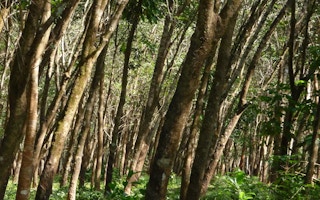Costa Rica is celebrating 200 years of independence this year. It is an opportunity to honor our ancestors and think about our descendants, and we invite the world to celebrate with us. Those who cannot visit in person should do so by protecting the Earth’s land and oceans, the source of all life.
Specifically, governments, businesses, communities, and individuals should commit to conserving at least 30 per cent of the planet’s land and oceans by 2030. Scientists have determined that this “30x30” goal is the minimum level of conservation needed to prevent a catastrophic loss of nature and to stem climate change.
But 30x30 will not happen by itself; it will require time, attention, and money. Economists estimate that achieving this goal – by conserving the world’s most important intact wild areas and restoring crucial degraded habitats – would represent less than one-third of the amount that governments spend on subsidies to activities that destroy nature.
It is encouraging that nine major philanthropic organisations recently pledged US$5 billion to the 30x30 effort, the largest donation to nature in history.
Others must now follow their lead. Sixty percent of the world’s terrestrial wildlife populations have been lost since 1970, and almost one-third of global fish stocks are being exploited at an unsustainable level. The destruction of natural areas also releases huge quantities of greenhouse gases, contributing to climate change.
True, the cost to protect nature may seem like a lot, especially as countries grapple with the economic fallout of the Covid-19 pandemic. But it is less than 1 per cent of global GDP (roughly US$87 trillion in 2019), and little more than one-third of the nearly US$2 trillion in total military spending worldwide in 2020.
“
Nature will repay us many times over for the investments we make.
Moreover, this sum is a fraction of what economies would lose should crucial ecosystems fail. The World Bank recently estimated that the collapse of three ecosystem services – pollination, food provision from marine fisheries, and timber from native forests – could reduce annual global GDP by US$2.7 trillion.
Because we cannot rely solely on private philanthropists to foot the bill, the necessary global investments must come from a combination of enhanced public and private finance. Every country must commit its share, with the G7 in particular leading the way with solid funding pledges.
Governments could free up additional resources by phasing out subsidies that harm nature instead of protecting it. For example, countries are currently negotiating at the World Trade Organisation to end US$35 billion in annual fishing subsidies that support large-scale industrial fleets and have driven the depletion of global fish stocks.
A substantial portion of the funds we need should go to low-income countries that host the majority of the world’s biodiversity. Costa Rica, for example, accounts for only 0.03 per cent of the planet’s landmass, but contains an estimated 5 per cent of its biodiversity. Furthermore, significant funds should be dedicated to protecting the land rights of indigenous peoples and local communities, who are nature’s best and most cost-effective stewards.
Nature will repay us many times over for the investments we make. The economic benefits of protecting 30 per cent of the world’s land and oceans by 2030 – including job creation in sectors such as forestry and tourism – would likely outweigh the costs by a ratio of at least five to one.
Costa Rica’s economy is based on nature-positive activities such as forest conservation, renewable electricity generation, and biodiversity protection. Since the 1980s, the country has stopped and then reversed forest loss, while the economy has grown by some 250 per cent in real terms. We now have a system of national parks and protected areas that cover more than 26 per cent of our land area.
Winning one of the first-ever Earthshot prizes will help us replicate in the ocean our successes on land. Already, an ambitious process is underway this year to enlarge protected areas from under 3 per cent of our oceanic territory to closer to the 30 per cent promised in our 2020 nationally determined contribution under the Paris climate agreement. My goal is to realize this massive expansion before I leave office.
Momentum toward 30x30 is growing. The High Ambition Coalition for Nature and People, led by Costa Rica, France, and the United Kingdom, has engaged over 70 countries in support of this goal. And 30x30 has become a crucial feature of the most recent draft of the Global Biodiversity Framework, which is set to be finalized by 196 countries at the United Nations Convention on Biological Diversity (CBD COP15) in Kunming, China, in 2022.
But actions speak louder than words. Governments, firms, and all of society must dedicate the financial resources needed to achieve 30x30.
Nature is the ultimate source of all our fresh water, food, clean air, and genetic resources for medicine and industry. It keeps dangerous pathogens in check and carbon in the ground, and generates green jobs. It is an irreplaceable source of human creativity, and spiritual and mental health.
Humanity is enmeshed in nature. Because we are capable of destroying it, we are responsible for protecting it. Let us decide now to invest the funds needed to fulfill that responsibility before it is too late.
Andrea Meza is Minister of Environment and Energy of Costa Rica.
© Project Syndicate 1995–2021










